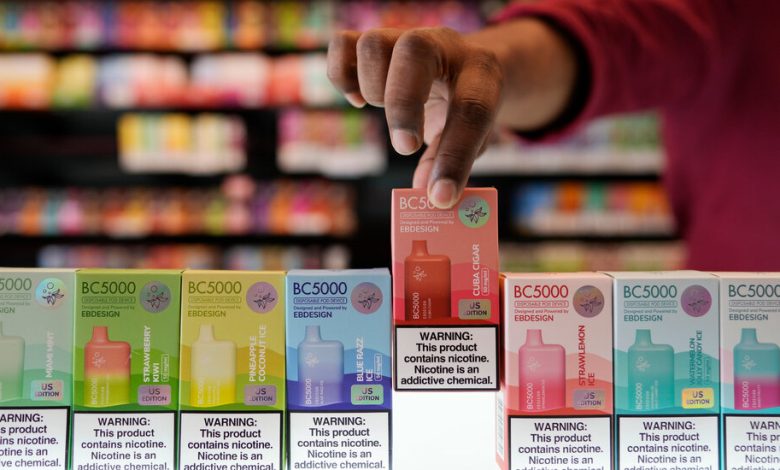Illicit E-Cigarettes Flood Stores as F.D.A. Struggles to Combat Imports

Juul was once the cool vape, blamed for hooking teenagers on e-cigarettes, and it is set to pay billions of dollars in legal settlements.
Then came Puff Bar, which was hot in high schools until federal officials began impounding those vapes. Elf Bar stepped in, and its products have been seized at the border. A parade of facsimiles is moving in right behind them: Virtue Bar, Juicy Bar, Lost Mary, Lost Vape and many more.
The latest flood of illicit e-cigarettes is arriving from China in Barbiecore colors and fruit, ice cream and slushy flavors, and accounts for a major share of the estimated $5.5 billion e-cigarette market in the United States.
The never-ending influx of vapes, some offering 5,000 or more puffs per device or escalating nicotine levels, has exposed a gaping lapse in enforcement by the Food and Drug Administration, which has authorized only a handful of the hundreds of options that line convenience store walls nationwide. Members of Congress, two dozen state attorneys general and even the Big Tobacco companies have stepped up their calls for the agency to get the situation under control.
Granted, the latest pleas by the tobacco industry are viewed by antismoking groups as a cringe-worthy effort to lock down market share, but some others interpret the addition of these odd bedfellows as a sign of a market run amok.
The F.D.A. “has been dealt a very difficult hand, and a lot of which includes putting the genie back — or stuffing the genie back — in the bottle,” said Erika Sward, assistant vice president of advocacy for the American Lung Association. “And I don’t envy them for that.”
Agency officials said they had used every tool within their authority to crack down on e-cigarette outlaws. Yet recent fines issued by the agency topped out at about $19,000 per violation and largely targeted a few products sold at each store. The agency’s orders telling six manufacturers to stop selling certain products were directed at U.S. stores, some of which were in small cities.
And though the F.D.A. has fired off hundreds of warning letters, the effect is barely felt: Flavored vape sales have surged 60 percent over the past three years, to 18 million vaping products a month in June from 11 million a month in early 2020, according to the C.D.C. Foundation.
“The F.D.A. should not be having any of these flavored e-cigarettes on the market,” said Yolonda Richardson, president of the Campaign for Tobacco-Free Kids. “And so it just needs to do its job.”
When the F.D.A. received expanded authority to regulate e-cigarettes in 2016, the objective was to draw a new line in public health: Smokers would have an alternative to traditional cigarettes, and tobacco use among minors would remain at historic lows.
Seven years on, nearly 40 percent of e-cigarette users are 25 or younger, according to the Centers for Disease Control and Prevention. And of the 2,000 or so vaping and e-cigarette products on the market, the agency has only given the green light to about two dozen of them, and it still has to deal with a backlog of applications, according to research on the industry.
There are few places where the problem feels more pressing than in high school bathrooms, where students crowd the stalls between classes to get a nicotine fix.
Teenage vaping rates have fallen roughly by half since their height during the Juul craze of 2019, to about 14 percent of high school students last year from nearly 28 percent at their peak, federal surveys show. Those rates were based on survey responses in which students said whether they had vaped within the past 30 days.
Kyle Wimmer, an art teacher at Mountain Range High School, north of Denver, frequently hears from students dealing with nicotine addiction from e-cigarette use.
He accepts discarded vapes and helps young people turn them into art. And as a teacher who has been open about his past struggles with alcohol, he’s also there to listen.
“It’s hard to tell kids not to do this when they’re hooked because they can’t just stop,” Mr. Wimmer said, adding: “They’re having troubles. They’re struggling.”
A growing body of research shows that while vapes may not be as toxic as cigarettes, they are far from healthy, particularly for adolescents who become addicted to nicotine while their brains are still developing.
The American Heart Association has raised the alarm about possible cardiovascular effects from e-cigarettes and called for more research. One recent meta-analysis reported higher heart attack risks in e-cigarette users than in those who did not vape or smokeanything. (Cigarette smokers had the highest risk.)
In recent years, the market has begun to move toward high-volume vapes advertising 5,000 to 6,000 puffs — with about as much addictive nicotine as is in a carton of cigarettes. The devices come in flavors that could appeal to younger adolescents such as birthday shake, gummy bear and watermelon ice, and they have higher concentrations of nicotine than were found before. The prices have also dropped, said Barbara Schillo, chief research officer for the Truth Initiative, who documented the trend in a recent study.
“In other words, these disposable devices are getting bigger, stronger and cheaper,” Dr. Schillo said.
Calls for change have only grown louder. In a letter sent in late August, 30 state attorneys general urged the F.D.A. to do more to deter youth vaping and to ban all but tobacco flavored e-cigarettes.
Lawmakers, including Senator Richard J. Durbin, Democrat of Illinois and a leading opponent of e-cigarettes, have pushed for action. His office discovered nearly two dozen types of vapes being sold online even after the F.D.A. had denied their marketing applications and sent them warning letters.
“I just don’t understand it,” Senator Durbin said in a floor speech last month, adding that the F.D.A. “is cowardly, refusing to use its full arsenal of enforcement tools — fines, injunctions — for even these most flagrant cases.”
Even R.J. Reynolds, the maker of Newport and Camel cigarettes and the best-selling Vuse vapes, has invoked public health in a petition lodged with the F.D.A. seeking official action. It asked the agency to prioritize enforcement of flavored, disposable vapes.
Luis Pinto, a spokesman for the company, said that devices aimed at young people and minors threatened the efforts of Reynolds and others to convert adult smokers to e-cigarette users. “The whole category is in peril,” he said.
Reynolds’s Vuse e-cigarettes led vaping sales for a year ending in August, Goldman Sachs data shows, with $2.2 billion in sales. The “other” category, which included flavored imports, trailed with $1.6 billion in sales, with Juul close behind.
Brian King, the F.D.A.’s tobacco center chief, said that the agency had ramped up warnings, fines and injunctions on illicit vape makers, sellers and distributors. He rebutted some of the criticism from “the cheap seats” and said enforcement efforts needed to be strategic and methodical.
“It’s a very complex chess match, not a game of tic-tac-toe,” Dr. King said. “And we need to ensure that the actions we take are both scientifically and legally defensible.”
F.D.A. officials meet regularly with Justice Department prosecutors, Dr. King said, describing them as critical partners. The agency has also worked with border authorities to seize imports of Elf Bar and Esco Bar products, he added. In addition, the agency has received funding to begin an effort to closely track the rapidly morphing vape marketplace.
“Nothing’s off the table when it comes to enforcement,” he said.
In late September, the F.D.A. announced 22 fines of $19,192 each against gas stations that received warning letters but did not stop selling Elf Bar products.
The F.D.A. has required e-cigarette makers to file applications to sell their products and to submit proof that the products would be likely to compel cigarette smokers to switch — but not to attract new users. The agency has denied millions of applications and let some top-selling products remain on market pending decisions.
Two years have passed since a court-imposed deadline required the F.D.A. to respond to all applications. Dr. King said it would finalize decisions, including on some Vuse and Juul vapes, by the year’s end.
The lengthy, opaque approval process, marked with legal challenges and defiance of the F.D.A.’s decrees, has opened the door to the shape-shifting influx of unauthorized vapes that come by air, land and sea from factories in China (where flavored vapes are outlawed).
The confusing mix of product statuses has prompted the Energy Marketers of America, an organization representing retailers, including convenience stores linked to gas stations, to file a petition with the F.D.A. seeking clarity about which e-cigarettes the stores can legally sell.
Stores are “well positioned to aid in the fight against illegal and dangerous products by keeping them off their shelves,” according to the petition.



